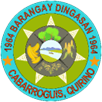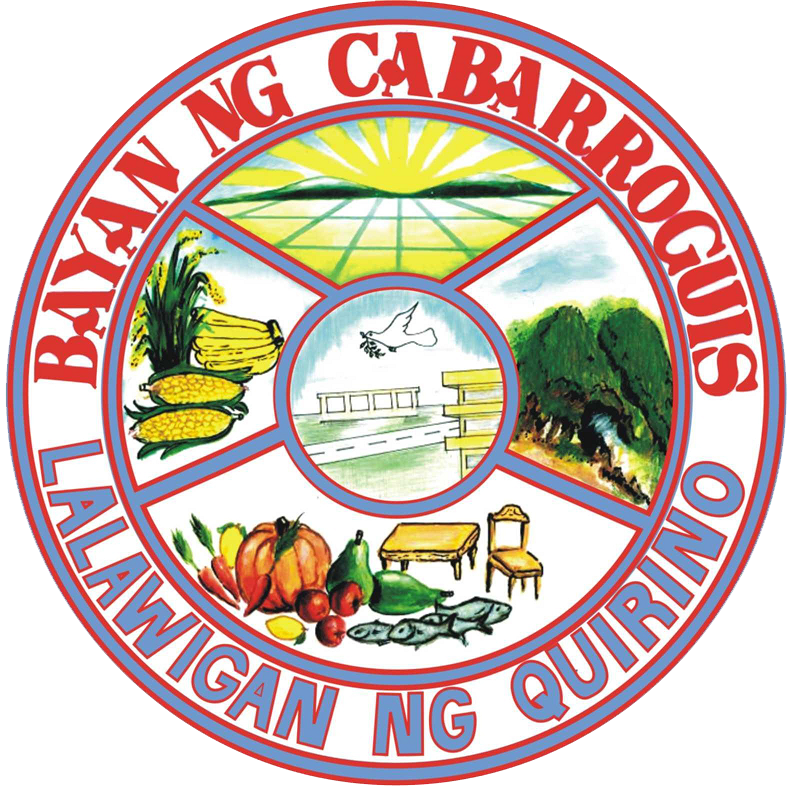Barangay Dingasan

Brief History
Barangay Dingasan was discovered sometimes in 1964 by a pioneer named Tutuyo Guinid who led a group of farmers from Pugol, Lamut, Ifugao thru the ….Commission on National Integration now NCIP. Upon reaching the place called Debibi, the pioneers were informed that the place derives its name from the Ilongot word (Dingas), which means “hot”. Accordingly, the place used to a hunting and fishing ground of the Ilongots and the Eatas (Pugot) tribe men. When the lowlanders particularly the Ilocanoes reached the place to fish and hunt for wild pig and deer, they were frowned upon and were hated by the aborigines of the place. This was because the lowlanders posed a threat to their source of livelihood. There were Ilocano’s who were murdered and the suspects were the Ilongots. Barangay Dingasan was weaned from the mother Barangay of Dibibi in the early of 1960’s. It is situated 35 kilometers south of Cabarroguis, the capital town of Quirino Province.
Creation And Its Founding Fathers
Barangay Dingasan was inhabited and dominated by Ifugaos who came from Ifugao province to look for a greener pasture in 1964. Among the leaders & elders who led in this area were ; Andres Tuguinayo (Head Petitioner) Carlos Pinkihan (recorder) Orlando Guinid Sr.(Tutuyo), Francisco( Hapao ) Dulnuan Sr. Ignacio Binlayan Sr., Alfredo Lupog, Tomas Tayaban, ,Donato Dulnuan, Domingo Mana-boy, Binwag Pinkihan, Pablo Atiwon, Antonio Danag , Bulti-ting Cuyahon,Ernesto, Lumawig, Benjamen Bolla , Santiago Manganawe , Luis Kimayong , Gomez Ambojnon , among others.
Table below shows the Barangay Chairmen who served in chronological order.
| NO. | NAMES OF BARANGAY CHAIRMAN | YEAR OF SERVICE |
| 1 | JUAN GARCIA | 1970 – 1974 |
| 2 | ERNESTO LUMAWIG | 1974 – 1977 |
| 3 | CARLOS DULNUAN | 1977 – 1980 |
| 4 | VICTOR D. TUGUINAYO | 1980 – 1982 |
| 5 | FRANCISCO (HAPAO) DULNUAN SR. | 1982 – 1987 |
| 6 | NESTOR C. DULNUAN | 1987 – 1989 |
| 7 | FELIPE DUHALNGON | 1989 – 1990 |
| 8 | DONATO DULNUAN SR. | 1990 – 1991 |
| 9 | NESTOR C. DULNUAN | 1991 – 1994 |
| 10 | EDWIN D. TUGUINAYO | 1994 – 1997 |
| 11 | NESTOR C. DULNUAN | 1997 – 2002 |
| 12 | ALBERTO B. BINLAYAN | 2002 – 2013 |
| 13 | JULIUS T. BULTING | 2013 – 2018 |
Mission
To Promote environmental awareness, livelihood program and government transparency trough good governance.
Vision
A showcase of agroforestry and ecotourism in the province supported by god fearing community, progressive, safe and clean environment through honest and dedicated leadership.
TOPOGRAPHY
Barangay Dingasan is situated along the western side of the Adalem /Diduyon river whose tributaries include the Kasibu river, Didipio river, Dibiwen river and Dingasan river. It is a mountainous and hilly with various indigenous trees like red and white lawan, narra, apitong, tangili and others various species. It has a rugged logging road from Barangay Dibbi to Sitio Tubo constructed in 1960’s during logging concessioners excel. Almost all Puroks has a logging road accessible during summer season but muddy during rainy season. The total land area is 3,108.06 hectares. The terrain in almost all puroks is rolling sloping wherein areas along the Adalem/Diduyon river were developed into corn land and rice field. The rest of the areas are forested subjugated by the residents for kaingin/slash farming.
DEMOGRAPHY
Table below shows the distribution of purok and its name.
| NUMBER OF PUROK | NAME OF PUROK |
| I | Katarawan and Centro |
| II | Bario Site and Upper |
| III | Surong |
| IV | Nagkularan and Kinugit |
| V | Kinugit and Dibiwen |
| VI | Tubo |
| VII | Pukeg |
Health Services
It has a Health Clinic that started s 1986 with a license midwife (Rebecca Lagadan) detailed until 1990. In 1995-96 volunteer midwife (Teresita Bandao ) was detailed but short after she went abroad in1996 a license Midwife ( Geneveive Pido) volunteered herself until recognized by the Municipal Health Office Cabarroguis as a Casual employee up to the present. Malaria used to be feared ailment during the 1970’s & 80’ until it vanished due to the health program of the government. Today Uti, colds and dengue are the prevalent sickness which can be prevented and avoided with the improved medical facilities.
Economic Activity and Resources
In 1970’s & 80’s the primary livelihood of the peoplewas slash farming (Kaingin system) planted with upland rice (aromatic rice) and bananas particularly lacatan, latundan and saba variety. Slash farming is the source of upland rice and banana, the main source of living. This activity resulted to the forest depletion and decreased the number of indigenous trees particularly Narra, red and white lawan, apitong, tangili and other hard woods. In 1980’s Tungro infested banana plantation particularly the lacatan(the most expensive banana) up to the present. It almost wipe out all bananas. This paves the construction of a Communal Irrigation at Purok 5 that irrigated a vast rice field at Kinugit and Dibiwen area. A huge irrigation system at Purok 3 was constructed aim to supply sloping areas along Dingasan creek and Purok I failed to operate due to damages. Other high value crops like citrus are planted in some selected areas. Planting of corn and other legumes is also a venture considering the fertile soil.
The National Greening program of the government includes Barangay Dingasan. In 2012 distribution of fruit bearing seedlings begun. Hundreds of seedlings like rambutan, coffee, cocoa, lanzones, sinkom, mango, guayavano among others were distributed particularly at Purok 3, 7 & 5. This will help protect the remaining forest. Dingasan is included among the Quirino Protected Areas. This shows evidence that Purk 5, particularly sitio Dibiwen has a vast water shed area, situated here is the Dibiwen Water Falls, a Tourist destination area.
Revenues
Projects and Program expenditures derived from the Internal Revenue Allotment amounting to Php1,100,000.00, in addition external sources like grants from Oeanagold Didipio Mine through the Social Development and Management Program Fund is a great help to further infrastructure projects and Social Services.
Education
Literacy rate is high due to the presence of two major Schools namely; Dingasan Integrated School situated at Purok 1 (centro) and Upper Dingasan Elementary School situated at Purok 6 (Sitio Tubo). The Establishment of School in 1975 is due to the generosity of Mr. Francisco (Hapao) Dulnuan who donated a 6 hectares Lot.as Dingasan Primary School until it became Elementary School. Year 2,000 when it was recognized as Dingasan Integrated School due to the increase of Population. The presence of High School in this area help a lot for parents who save board and lodging for their children.
Upper Dingasan Elementary School was established on August 4, 1994 situated at Sito Tubo (Purok 6), 6 kilometers away from Dingasan Integrated School (Centro). The School was established upon the vision of then Kagawad Donato Dulnuan and Luis Baywong with the help of then Barangay Chaiman Edwin Tuguinayo who sponsor a Resolution address to DECS (Dep-ED) supported by then Dr. William Binwag (District Supervisor). The generosity of Luis Baywong, Bu-ucan Buyuccan, and Anthony Kimayong who jointly donated the School lot has contributed to the establishment of the school. Ms. Mary Jane Kindipan is the pioneer teacher (1994) until transfer at Barangay Tucod in 1995. Subsequently Mrs. Lilian P. Hangdaan took over in 1995 up to the present. Today Upper Dingasan has a five (5) teaching staff, namely Yolanda B. Bandao, Dina L. Bandao, Helen B. Pumihic, Conchita B. Ananayo,( these are the second generation who excel in their studies and got to work) and Nellie M. Balog. The teaching staff is headed by Lilian P. Hangdaan who passed the National Qualification Examination for Principals. At present Upper Dingasan Elementary School has enrollees of 97 pupils and has a cluster school, Pukeg Primary School situated at Purok 10, Dingassan.
Culture and Beliefs
Ifugaos are the dominant people with 96%, Ilocano’s 3% and Ibaloy’s 1%. Ifugao traditions and costumes are being observed particularly on wedding celebration(Inbango) wherein wine are being served while giving of gifts to the bride and groom. Respect for the elderly is being attributed especially in the family cycle, as well as the observance of kin relationship, Bayanihan system and the wearing of native attire during ceremonial occasion is maintained. The coming of Christianity, good culture were preserved but the Baki (ritual prayer) and Bogwa (cleaning of remains of dead person) is being forsaken. Christianity encompasses religious affiliation, Catholics 39%%, Assembly of God 40% (Full Gospel), Esperitista accounts 19% , Iglesia 1%, Pagan 1% Christianity has a great impact to the community wherein crime rate is low and morality of the community is being regarded.
Peoples Organization and Cooperatives
The people are spiritually and socially active, this shows the presence of Rural Improvement Club, a women’s organization funded by the Provincial Government whose aim is to pursue livelihood programs run by its women officers,. Senior Citizen’s organization has a similar scheme wherein revolving funds are being lend to its members with a minimal interest. Farmers Irrigators Association was formed to look for the welfare of farmers benefiting the supply of irrigation system. Kabinnulig, a men’s organization whose aim is to promote Bayanihan system among family heads is also active in the area. A newly re-organized Cooperatives was formed (2013) –‘Dingasan Binnaddang Muti-Purpose Cooperative’, it was formed to unite sectoral groups and individual to encourage thriftiness and promote communal livelihood programs. It will channel grants from external sources like funds from OceanaGold-Didipio Mine and to other Government agencies. A combined Motto is “Forward Dingasan”.

